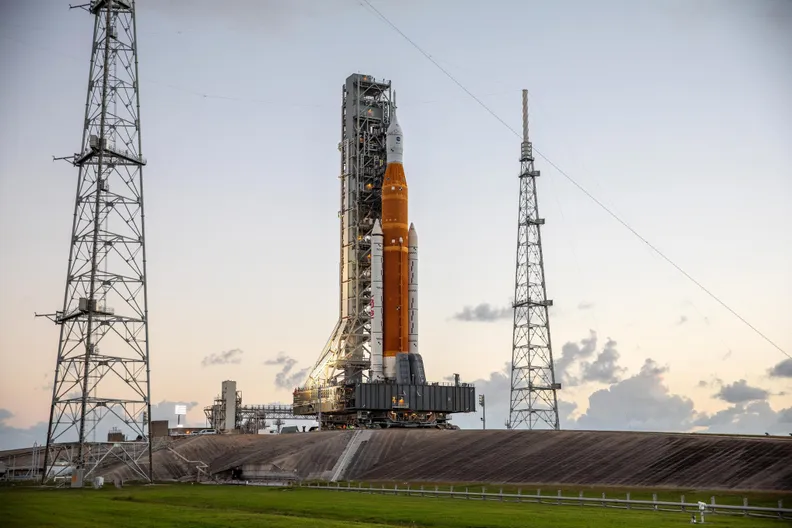NASA’nın Uzay Fırlatma Sistemi (SLS) roketi ve Orion uzay aracı, Avrupa Servis Modülü ile 4 Kasım 2022’de NASA’nın Florida, ABD’deki Kennedy Uzay Merkezi’ndeki Launch Pad 39B’ye varıyor. Artemis I görevi, SLS’nin ilk testi olacak ve Orion ve Avrupa Hizmet Birimi. Kredi bilgileri: NASA/Kim Shevlet
Artemis I mega Ay roketi fırlatma rampasında[{” attribute=””>NASA’s Kennedy Space Center in Florida. This powerful Space Launch System (SLS) rocket is getting ready to launch the Orion spacecraft and its European Service Module. The first opportunity for launch is November 16 at 1:04 a.m. EST/local time (07:04 CET, 06:04 GMT).
Artemis I is the first mission in a large program to send astronauts around and on the Moon sustainably. This uncrewed first launch will see the Orion spacecraft travel to the Moon, enter an elongated orbit around our satellite, and then return to Earth. The Orion spacecraft is powered by the European-built module that supplies electricity, propulsion, fuel, water, and air in addition to keeping the spacecraft operating at the right temperature.

Artemis I mission overview. Orion is NASA’s next spacecraft to send humans into space and is part of the Artemis program. It is designed to send astronauts farther into space than ever before, beyond the Moon and to the lunar Gateway. Credit: ESA–K. Oldenburg
Artemis to the Moon
The European Service Modules are made from components supplied by over 20 companies in ten European Space Agency (ESA) Member States and the United States. As the first European Service Module sits atop the SLS rocket on the launchpad, the second is only 8 km (5 miles) away, as it is currently being integrated with the Orion crew capsule for the first crewed mission – Artemis II. The third and fourth European Service Modules – that will power astronauts to a Moon landing – are in production in Bremen, Germany.

Contributions in Europe for the European Service Module that is powering the Artemis missions around the Moon. Credit:
ESA–K. Oldenburg
The Artemis program is an international endeavor to build a permanent outpost around and on the Moon. Modules for the lunar Gateway are being built in the United States and Europe, with the first European module – International Habitat – in production in Turin, Italy, and set for launch on the fourth Artemis mission alongside the Orion spacecraft.
The first Artemis launch this week is without humans, but three mannequins have been placed in the spacecraft’s seats to conduct scientific research. Fitted with more than 5600 sensors, two mannequins will measure the amount of radiation astronauts could be exposed to in future missions with unprecedented precision. ESA is also including active radiation dosimeters in the Crew Module to get more data on how radiation levels change on a mission to the Moon – building on the leadership developed over decades of radiation research on the International Space Station.

Logo for the first European Service Module (ESM) that is powering NASA’s Orion spacecraft to send humans into space and the Moon as part of the Artemis program. Credit: ESA
Dates
With a November 16 launch, the three-week Artemis I mission would end on December 11 with a splashdown in the Pacific Ocean. The European Service Module detaches from the Orion Crew Module before splashdown and burns up harmlessly in the atmosphere, its job complete after taking Orion to the Moon and back safely.
Backup Artemis I launch dates include November 19. Watch the launch live on ESA Web TV.
Avrupa Servis Modülü ile donatılmış Orion uzay aracı, daha önce insan tarafından sınıflandırılan herhangi bir uzay aracından daha fazla Dünya’dan uçacak. Bu video, Avrupa Uzay Ajansı’nın uzay aracını çalıştıran Avrupa Hizmet Modülüne odaklanarak, Artemis’in astronotsuz ilk görevine genel bir bakış sunar. Uzay aracı, hız kazanmak ve kendisini aydan 70.000 kilometre uzağa, Dünya’dan yaklaşık yarım milyon kilometre uzağa itmek için ay yerçekimini kullanarak ayın üzerinde uçacak – kendini uzak bir retrograd uçuşa pompalayacağı için, herhangi bir insanın seyahat ettiğinden daha uzağa gidecek. ayın etrafında döner. Dönüş yolculuğunda Orion, Dünya’ya dönmeden önce Ay’ın bir başka uçuşunu yapacak. Toplam yolculuk yaklaşık 20 gün sürecek ve suyun ESU olmadan Pasifik Okyanusu’na akmasıyla sona erecek – atmosferde zararsız bir şekilde ayrılıyor ve yanıyor. Kredi: ESA – Avrupa Uzay Ajansı






